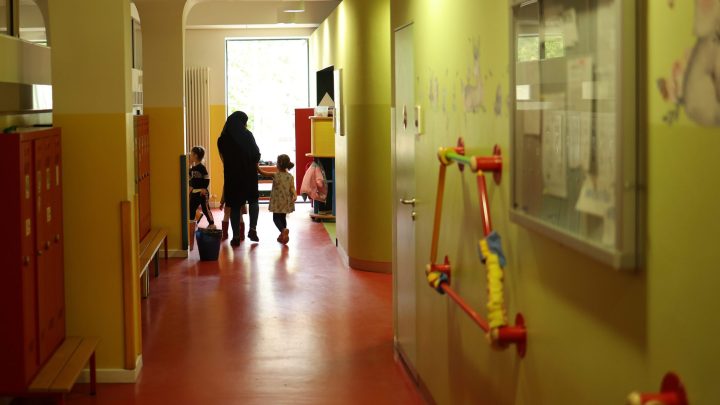
End to some pandemic-era child care subsidies could make hiring harder
End to some pandemic-era child care subsidies could make hiring harder

It’s lunchtime at Downtown Baltimore Child Care, and the preschoolers are getting ready for a race to see who can drink their milk first.
“Oh, you want to have a milk race with me?” asked teacher Ebony Goins. “Let’s go for it.”
The kids and Goins down their cups, all declaring victory. “My bones are now strong!” announced Goins.
She’s one of 85 teachers here. The organization prides itself on having one teacher for every seven preschoolers (and one for every two infants). That allows for fun activities like that milk race.
To recruit and keep those teachers, Downtown Baltimore Child Care has prioritized payroll. The nonprofit organization, which has three centers across Baltimore, received just over $1 million in federal pandemic relief funds. The vast majority went toward wages. The deadline to spend those funds just passed at the end of September — the so-called “child care cliff.” There was over $37 billion awarded to hundreds of thousands of providers across the country. Now that the money is gone, it could affect providers’ ability to recruit and retain workers.
“It really was sort of this makeshift scaffolding that’s boosting up this — I think of it as a ramshackle mansion,” Elizabeth Pufall Jones with the Center for the Study of Child Care Employment at the University of California-Berkeley. “Those funds are now ending … so all of that scaffolding is going to fall down.”
And, she added, we don’t know yet how much of that mansion we’re going to lose.
“We went over with a whimper instead of a boom,” said Hilary Roberts-King, executive director of Downtown Baltimore Child Care. “Over time, we’ll see what the impacts are.”
Roberts-King said she’s fundraising and applying for grants to try to make up for the loss of federal funds. She’s also keeping an eye on costs — putting off replacing the windows, for instance — and giving smaller raises than she would have liked.
“This past year, we had to do 4% for people who make less and 2% for people who make more, because that was what it took to get us over the finish line,” said Roberts-King. “And it wasn’t great news.”
All the employees here make at least $15 an hour, more than a dollar over the median wage for child care workers across the country, which is $13.71. Still, Roberts-King said having less money affects her ability to hire.
It also affects current staff members.
“The pay in this career is not enough,” said Tiffany Thornton, a teacher with Downtown Baltimore Child Care. She loves the work, but said she still has to supplement her income.
“I’ve been here 20 years, and I still do side jobs. I babysit on the side, I do Instacart on the side,” said Thornton.
Thornton has held off having kids of her own. She’s worried she wouldn’t be able to afford it. She’s 39.
“I don’t have a lot of time to figure that out. I’m getting older,” said Thornton. “But no, I don’t have kids. And that’s one of the reasons why: Child care is expensive.”
Thornton said she’ll stick with the work, because she is, at her core, an early childhood educator.
“It’s not just a job for me. I really enjoy this. I went to school for it. And I’ve done this basically my whole life,” said Thornton. “What else would I do?”
But others have left the industry. There’s more than 38,000 fewer child care providers now than in February 2020.
There’s a lot happening in the world. Through it all, Marketplace is here for you.
You rely on Marketplace to break down the world’s events and tell you how it affects you in a fact-based, approachable way. We rely on your financial support to keep making that possible.
Your donation today powers the independent journalism that you rely on. For just $5/month, you can help sustain Marketplace so we can keep reporting on the things that matter to you.











